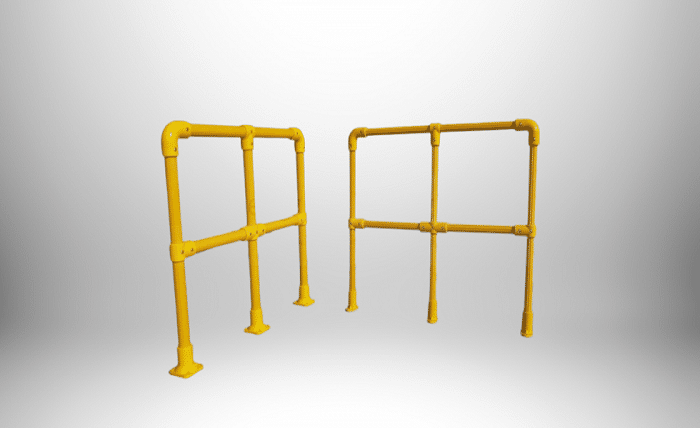FRP Handrail: The Durable, Safe Choice for Public Projects

Introduction
In the search for industrial-grade handrails that can endure harsh conditions and provide long-lasting safety, FRP handrails are becoming a top choice in public and industrial infrastructure projects. FRP, or Fiber Reinforced Plastic, combines durability, resistance to corrosion, and low maintenance, making it a strong alternative to traditional materials like steel and wood. From large public walkways to coastal installations, FRP handrails deliver safety and sustainability in demanding settings. This article explores why FRP handrails are a durable, low-maintenance solution for public infrastructure, especially for projects needing reliable safety features in challenging environments.
What Makes FRP Handrails Ideal for Public Projects?
FRP handrails are crafted from a blend of resin and reinforcing fibers, creating a composite material known for exceptional strength and flexibility. This combination gives FRP handrails a distinct advantage over conventional options like steel or wood. Where traditional materials are vulnerable to corrosion, wear, and environmental damage, FRP handrails excel, offering long-term performance and a maintenance-friendly design. Ideal for high-traffic public spaces, parks, and pedestrian bridges, FRP handrails provide the safety, durability, and low upkeep that modern infrastructure projects demand.
Why FRP handrails are the best choice for Australian infrastructure projects shows the unique benefits FRP brings to these environments, ensuring that projects remain both safe and sustainable over time.
Key Benefits of FRP Handrails for Public Use
Selecting FRP handrails comes with a set of significant advantages, especially for large-scale projects where reliability and low maintenance are essential.
- Corrosion Resistance: Unlike metals that rust over time, FRP handrails are built to resist corrosion, making them particularly valuable in industrial and outdoor environments. This resistance translates to reduced maintenance and longer service life in projects near the coast or where chemical exposure is high.
- Lightweight and Easy Installation: FRP handrails are significantly lighter than metal alternatives, making transport and installation easier and less costly. In projects with extensive infrastructure, this weight advantage leads to faster installations, lowering project costs and timelines.
- Low Maintenance Needs: FRP handrails require minimal upkeep, as they resist rust, fading, and environmental wear. For public infrastructure, this means fewer disruptions and lower maintenance budgets, which is an important benefit for projects on a tight budget.
- Durability in All Conditions: Whether exposed to intense sun, rain, or saltwater, FRP handrails maintain their structural integrity. This durability makes FRP an effective solution for infrastructure that requires consistent performance over time, regardless of environmental challenges.
- Enhanced Safety Standards: FRP handrails meet the necessary safety requirements for public projects, providing slip-resistant surfaces and reliable support for public spaces. They provide an extra measure of security, particularly in high-traffic areas.
Common Applications of FRP Handrails in Public Infrastructure
FRP handrails are commonly used across a range of public infrastructure and industrial applications due to their strength and adaptability:
- Public Walkways and Parks: These environments benefit from FRP’s corrosion resistance, especially where frequent maintenance would be impractical. The result is a safer, long-lasting solution for public safety in areas with high foot traffic.
- Bridges and Pedestrian Overpasses: In areas where infrastructure faces the elements, FRP handrails excel due to their resilience against weather extremes, from saltwater exposure to UV radiation.
- Schools and Recreational Facilities: FRP handrails are ideal for high-traffic areas, where their slip resistance and safety compliance help protect visitors and users, ensuring the reliability essential for public institutions.
FRP Handrails vs. Traditional Materials
When comparing FRP handrails with traditional materials like steel, wood, or aluminum, several key distinctions emerge that make FRP handrails particularly advantageous:
- Longevity and Maintenance Needs: FRP handrails require significantly less maintenance than traditional options, such as steel that may rust or wood that deteriorates over time. This reduced maintenance need extends the product’s life and reduces costs associated with regular upkeep.
- Environmental Impact: FRP’s resistance to corrosion and environmental degradation contributes to a lower overall footprint, making it a sustainable choice for projects prioritizing long-term, eco-friendly materials.
- Weight and Installation Ease: Due to its lightweight nature, FRP is easier to transport and install than most metals. For projects with complex installations or those in remote areas, this ease can streamline processes and reduce costs.
In projects where lifespan, cost-efficiency, and sustainability are priorities, FRP handrails stand out as a compelling option that rivals—and often exceeds—the performance of traditional materials.
Why FRP Handrails are Perfect for Public Safety
Public safety standards are critical when choosing materials for infrastructure, and FRP handrails offer essential features that ensure they meet or exceed these standards. FRP materials are non-conductive, non-corrosive, and designed to maintain stability, even in extreme weather conditions. These properties make FRP handrails safe for pedestrian use, especially in settings where handrails are exposed to environmental stresses or corrosive elements. Furthermore, FRP handrails are built with slip-resistant surfaces, providing added security for the public and ensuring compliance in high-traffic areas.
Conclusion
For infrastructure projects that require durable, low-maintenance solutions, FRP handrails offer a smart choice. Their corrosion resistance, strength, and low upkeep make them ideal for public spaces, industrial settings, and other high-use environments. From parks and walkways to bridges and schools, FRP handrails provide an adaptable, long-term solution that ensures safety and sustainability across varied applications. As industrial projects increasingly prioritize resilient materials, FRP handrails stand out as a dependable choice for meeting today’s demands for durability and safety.
CTA: Contact Us for Quality FRP Handrails for Your Public Project Needs
To learn more about how FRP handrails can improve safety and reduce maintenance needs in your next public project, contact us for details on available options. We’re here to help with handrails designed for strength, reliability, and lasting performance.
FAQs
- What is an FRP handrail, and how does it differ from traditional materials? An FRP handrail is made from fiber-reinforced plastic, known for high durability and corrosion resistance. Unlike steel or wood, FRP won’t rust or degrade over time, making it ideal for harsh environments and industrial applications.
- Are FRP handrails suitable for all weather conditions? Yes, FRP handrails are designed to withstand extreme conditions, from sun exposure to heavy rainfall and saltwater, making them ideal for outdoor infrastructure projects.
- How do FRP handrails contribute to public safety? FRP handrails meet essential safety standards, providing slip-resistant surfaces and stable support in public areas. Their strength and corrosion resistance make them a safe and reliable choice.
- What are the primary applications for FRP handrails in public infrastructure? FRP handrails are widely used in parks, bridges, walkways, and recreational facilities, providing a long-lasting, low-maintenance safety solution suitable for public spaces.




